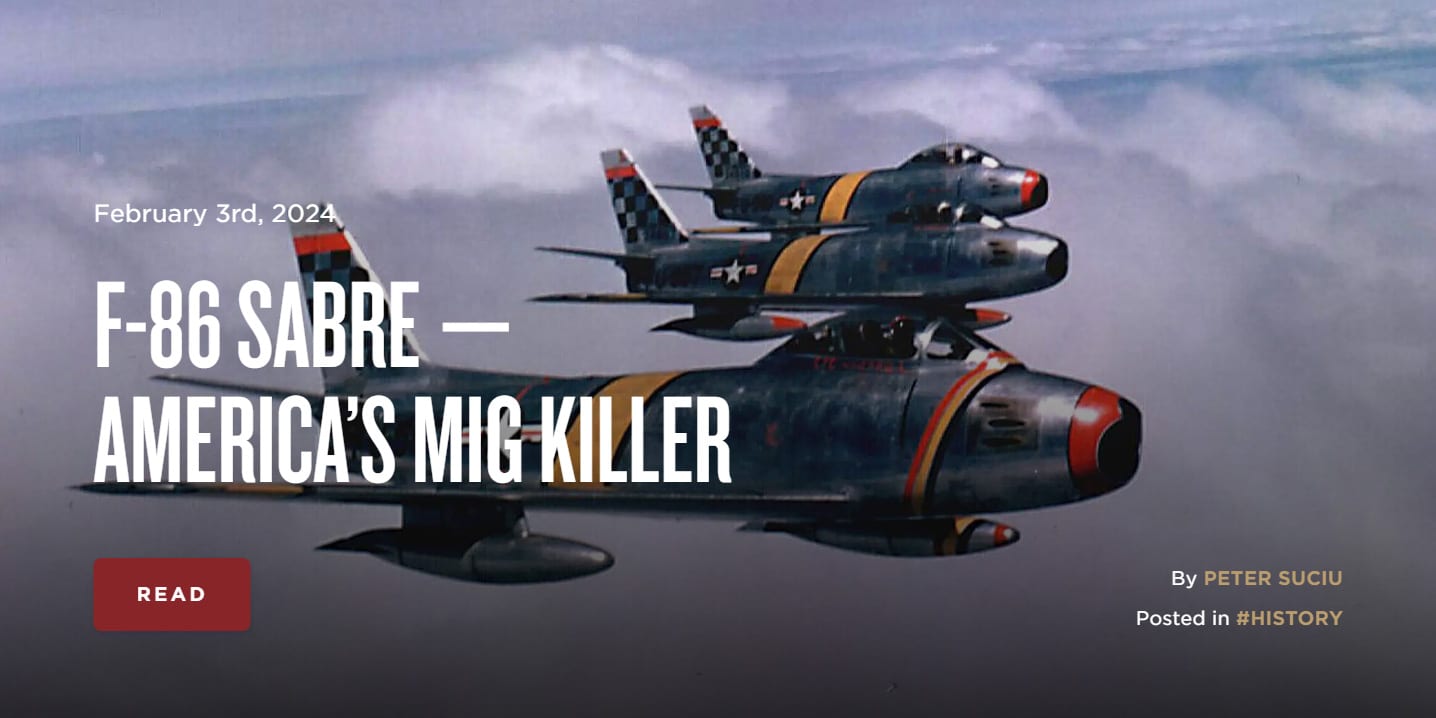Hello all, here is today's article posted on TheArmoryLife.com. It is titled “F-86 Sabre — America’s MiG Killer” and can be found at https://www.thearmorylife.com/f-86-sabre/.



There is an F-86 on static display at Hickam AFB. I agree that it's one of the best looking aircraft I've ever seen.The author failed to mention that the Sabre is one of the prettiest airplanes ever produced. The Mustang was the best looking prop plane ever.
Umm.. fighter to fighter it's more even than you think. Here are the specs:Brothers, my understanding is that, compared to the Mig 15, our F-86 was underpowered and outgunned. I would rather have flown the Soviet shiner, I think.
yeah... but it was ugly. like a flying cigar with wings. hehehe.Brothers, my understanding is that, compared to the Mig 15, our F-86 was underpowered and outgunned. I would rather have flown the Soviet shiner, I think.
Really enjoyed this article on one of my favorite USAAF/USAF fighter jets. I was a bit dismayed at the doubts cast on the Sabre aerial victories from the Korean War. American forces have always maintained high reporting and confirmation requirements. This is particularly true in comparison to Communist China and Soviet Russia (let alone NKorea).Hello all, here is today's article posted on TheArmoryLife.com. It is titled “F-86 Sabre — America’s MiG Killer” and can be found at https://www.thearmorylife.com/f-86-sabre/.

The F-86H (Fighter/Bomber) were always equipped with quad 20mm cannon. The F-86F was the transitional Sabre model. Wartime testing of “Project Gun-Val” modified F-86F (designated F-86F-2) demonstrated the superiority of cannon armament and munitions over the Heavy Machine Guns.Good article! Good stuff.
The "cover photo" shows F-86Fs of the 51st Fighter Interceptor Wing in Korea, late-war.
Not all F-86Hs had the 4x20mm armament. The first batches of them had the same 6x.50 armament of previous Sabres. I don't know the number of each off the top of my head, but I have that information around here somewhere, I assure you.I THINK the early F-86Hs might have been the last fighters built for the USAF armed with .50s, but I'd have to doublecheck that.
Many of the pics in the article are of F-86As of the 4FG/4FIW in the first year or so of the Korean War.
Not so. See the photo and story I posted above. That's an early F-86H armed with 6x.50, as you can clearly see in the photo. It was flown by a friend of my Dad's, a man I knew very well, and was probably flown by my Dad too at least sometimes. My Kid has Dad's logbooks--I can check them for the serial number.The F-86H (Fighter/Bomber) were always equipped with quad 20mm cannon.
I'd like to spend a rainy day sitting among a pile of those books.Not so. See the photo and story I posted above. That's an early F-86H armed with 6x.50, as you can clearly see in the photo. It was flown by a friend of my Dad's, a man I knew very well, and was probably flown by my Dad too at least sometimes. My Kid has Dad's logbooks--I can check them for the serial number.
Just had a better idea--I have the unit history book right here. There are five identifiable photos of Sabres in it, all F-86H-1s, and all armed with 6x.50s. In the back of the book is a chart listing all the aircraft ever assigned to the 167th. A quick count shows 29 F-86H-1s with serial numbers ranging from 52-1989 to 52-2089.
As many books on F-86 as I have around here, I should be able to find the block number where the armament switch came, and the serial number, and thus the total number of H-1s produced. Obviously at least 100, from the SNs in the 167th book.
So would I. Too busy these days wasting time on the computer.I'd like to spend a rainy day sitting among a pile of those books.
